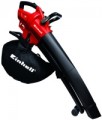Max. air flow rate
The highest speed of the air stream given out by the vacuum cleaner. The
higher this parameter, the stronger the thrust provided by the device, and the more efficiently it is able to pull or blow out debris particles from cracks and other hard-to-reach places (of course, if there is an appropriate operating mode — see above). At the same time, in most modern models, this figure exceeds 150 km/h — this is more than enough for work of small and medium complexity. Therefore, paying attention to a high flow rate makes sense only when choosing a powerful model for working in difficult conditions; we note that in the most “high-speed” vacuum cleaners, the indicators can exceed 400 km/h.
Air flow (suction)
Performance of the garden vacuum cleaner when working on suction (see "Operating mode").
As with blowing described above, this parameter primarily characterizes how large the area covers the vacuum cleaner when working:
high performance means that the device captures more air and draws debris from a larger surface. But this indicator is weakly related to suction efficiency: the ability of a vacuum cleaner to “pull out” debris particles from cracks, thick grass, etc. depends primarily on speed characteristics, not performance.
Garbage container volume
The volume of the garbage collector — a container for garbage — regularly supplied with a garden vacuum cleaner. The larger the bin, the more debris can fit inside and the less often you have to empty it during work. On the other hand, a capacious container has the appropriate dimensions, and when filled, it also weighs a lot, which can affect the ease of use of the vacuum cleaner (this is especially true for manual and backpack models, see "Type"). Therefore, manufacturers tend to choose bins for their products based on the overall level of the vacuum cleaner and the scale of work for which it is designed. And some units may not be equipped with complete containers at all — in the expectation that the user picks up such a container separately.
The volume of the garbage can can be approximately estimated, knowing that an ordinary household bucket holds about 10 – 12 liters. Thus, for example, a 35 liter container corresponds approximately to three standard buckets.
Motor power
Power of the garden vacuum cleaner motor, expressed in watts. This unit is by far the main one, it is used for both electric and gasoline engines (see "Engine type").
The
more powerful the motor — the more air the vacuum cleaner is able to pass through itself, the greater the speed it is able to give the air flow and the more efficient the chopper (if there is one at all — see "Operating mode"). At the same time, all these moments depend not only on power, but also on many other design features; and manufacturers select each motor in such a way as to provide the vacuum cleaner with certain performance characteristics. Therefore, when choosing, it is worth looking primarily at practical characteristics (flow rate, blowing and suction performance), and engine power is of secondary importance.
Max. engine speed
The highest speed at which the vacuum cleaner engine is able to operate in normal mode.
Theoretically, faster motors are capable of delivering more solid performance; however, in fact, these characteristics depend on so many different design features that the engine speed is practically lost against the background of these features. Therefore, this moment, in fact, is purely reference (and partly promotional — impressive rpm numbers can at first glance give the impression of high power and performance; but this impression is often deceptive).
Support wheels
The presence of
support rollers in the design of a garden vacuum cleaner.
Support rollers are found only in manual models (see "Type"). They, usually, are located under the bell — in such a way that the unit can be put on rollers, holding the control handle, and the bell is at a certain distance from the ground. This greatly facilitates the work — instead of holding the vacuum cleaner on the weight, you can roll it on the ground without much strain on your hands.
The rollers are often made removable — so that they do not hang like a "dead weight" when working with a vacuum cleaner on weight.
Noise level
The noise level generated by the vacuum cleaner during normal operation. The lower this indicator, the more comfortable it is to work with the unit, the less the operator gets tired; and high noise levels may require the use of protection (e.g. earmuffs).
When assessing the noise level, note that the decibel used to measure this level is a non-linear quantity. Therefore, it is easiest to evaluate specific values using comparative tables. Here is one of the variants of such a table (rather simplified):
— 60 dB — sound comparable to a TV at medium volume. From this value, the indicators of modern garden vacuum cleaners begin, because. this technique works quite loudly.
— 70 dB — to a truck at a distance of about 8 m;
— 80 dB — traffic noise on a busy street;
— 90 dB — freight train noise at a distance of 8 – 10 m;
— 100 dB — the noise of the demolition hammer;
— 110 dB — indoor rock concert
Weight
The total weight of the garden vacuum cleaner. Usually, this paragraph indicates the "net" weight of the unit — with an empty dust container (or even without a dust container at all), without fuel and oil (in models with an internal combustion engine, see "Engine type"), without a battery (in the corresponding devices, also see "Engine type"), etc. This parameter is important primarily for models designed to
be carried "on oneself" — that is, hand-held and knapsack (see "Type").

